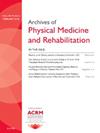预测设备实现潜力:基于DART框架的工具的开发和验证
IF 3.6
2区 医学
Q1 REHABILITATION
Archives of physical medicine and rehabilitation
Pub Date : 2025-05-01
DOI:10.1016/j.apmr.2025.03.032
引用次数: 0
摘要
加速翻译设计(DART)框架确定了影响翻译速度的因素。本研究概述了康复技术DART (DART- rt)的发展和验证。我们假设基于调查的工具可以根据最终用户对七个决定因素的评估来预测设备实施的准备情况:成本、安全性、有效性、临床需求、患者价值、相对优势和临床效用。方法dart - rt的开发分为三个阶段:1)项目开发,2)量表开发,3)量表评定。在第一阶段,内容专家生成并审查了神经康复技术的项目和描述。第二阶段包括对最终用户(即康复临床医生、提供者、患者和工程师)的认知访谈。该调查随后在终端用户中进行了试点测试。第三阶段包括探索性因子分析、模型拟合、信度和效度。结果第一阶段得到了12种神经康复工具的描述和DART框架定义的7种结构。阶段2迭代地访问了6个最终用户,以评估问题的适当性和回答的强度。试点数据包括104份回复。初步的因子分析和模型拟合表明,结果加载为两个因子(<;0.4)确定为F1:可行性(成本、安全性、有效性)和F2:实施潜力(临床需求、患者价值、相对优势和临床效用)。初步模型拟合良好(CFI: 0.969, SRMR: 0.064, RMSEA: 0.054)。结论dart - rt解决了描述实施潜力的复杂性。了解实施的潜在概况可以告知一项技术是否已经准备好用于临床实施,是否需要进一步改进,或者是否缺乏可行性。本文章由计算机程序翻译,如有差异,请以英文原文为准。
Predicting Device Implementation Potential: Development and Validation of a Tool Based on the DART Framework
Introduction
The Design for AcceleRated Translation (DART) framework identifies factors that impact translation speed. This study outlines the development and validation of the DART for Rehabilitation Technologies (DART-RT). We hypothesized a survey-based tool could predict the readiness for implementation of a device based on end-user evaluations on seven determinants: cost, safety, effectiveness, clinical demand, patient values, relative advantage, and clinical utility.
Methods
DART-RT was developed through three phases: 1) item development, 2) scale development, and 3) scale evaluation. In Phase 1, content experts generated and reviewed items and descriptions of neurorehabilitation technologies. Phase 2 included cognitive interviews with end users (i.e., rehabilitation clinicians, providers, patients, and engineers). The survey was then pilot-tested with end users. Phase 3 included exploratory factor analysis, model fit, reliability, and validity.
Results
Phase 1 resulted in 12 descriptions of neurorehabilitation tools and seven constructs as defined by the DART framework. Phase 2 iteratively interviewed six end users to assess the questions' appropriateness and the responses' strength. The pilot data included 104 responses. Preliminary factor analysis and model fit indicate results load into two factors (< 0.4) determined to be F1: Viability (cost, safety, effectiveness) and F2: Implementation potential (clinical demand, patient values, relative advantage, and clinical utility). Preliminary model fit was adequate (CFI: 0.969, SRMR: 0.064, RMSEA: 0.054).
Conclusions
DART-RT addresses the complexity of describing implementation potential. Understanding implementation potential profiles can inform whether a technology is ready for clinical implementation, requires further refinement, or lacks viability.
求助全文
通过发布文献求助,成功后即可免费获取论文全文。
去求助
来源期刊
CiteScore
6.20
自引率
4.70%
发文量
495
审稿时长
38 days
期刊介绍:
The Archives of Physical Medicine and Rehabilitation publishes original, peer-reviewed research and clinical reports on important trends and developments in physical medicine and rehabilitation and related fields. This international journal brings researchers and clinicians authoritative information on the therapeutic utilization of physical, behavioral and pharmaceutical agents in providing comprehensive care for individuals with chronic illness and disabilities.
Archives began publication in 1920, publishes monthly, and is the official journal of the American Congress of Rehabilitation Medicine. Its papers are cited more often than any other rehabilitation journal.

 求助内容:
求助内容: 应助结果提醒方式:
应助结果提醒方式:


